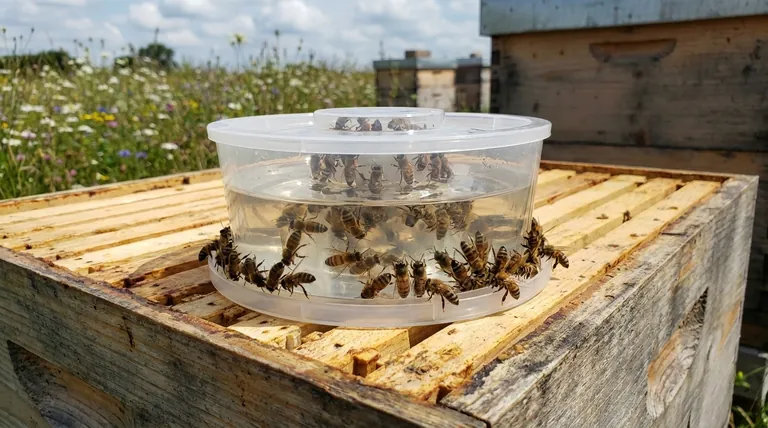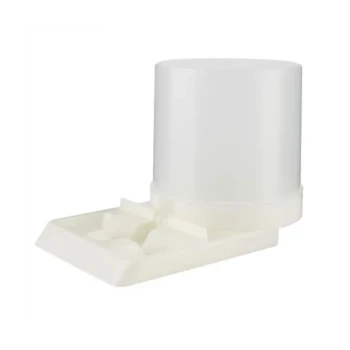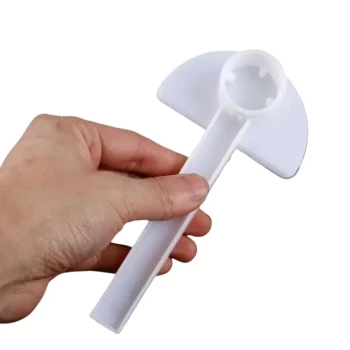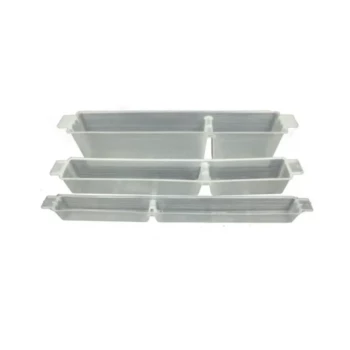At its core, a bee rapid feeder is a specialized tool designed to provide a large volume of supplemental food—typically sugar syrup—to a honey bee colony quickly and safely. While they can also be used to provide water, their primary function is to deliver nourishment during periods when natural nectar sources are scarce, effectively preventing starvation and stimulating colony growth.
The true purpose of a rapid feeder extends beyond simply providing food. It is a strategic management tool that allows a beekeeper to intervene at critical moments to ensure a colony's survival, build its population, and prepare it for seasonal challenges.

Why Use a Feeder? Core Scenarios
Understanding when to feed is as important as knowing how. A feeder is not a permanent fixture but a temporary support system used in specific situations.
Preventing Starvation
The most critical use for a feeder is to prevent a colony from starving. This is essential during a nectar dearth—a period when flowers are not producing nectar.
Common dearth periods include late autumn and winter when the colony is clustered for warmth, or during prolonged dry spells in the summer that inhibit flower production.
Stimulating Colony Growth
Providing a steady supply of syrup mimics a natural nectar flow. This signals to the queen that resources are abundant, encouraging her to increase her egg-laying rate.
This technique is vital for helping a newly installed package of bees or a small nucleus colony rapidly build its population and become established.
Aiding in Comb Construction
Bees consume a large amount of energy to produce wax and build out honeycomb. It is estimated that they need to consume about eight pounds of honey or syrup to produce one pound of wax.
Feeding a new colony helps provide the necessary fuel to draw out the comb on new frames, creating the essential structure for raising brood and storing food.
Providing a Safe Water Source
While its main purpose is for syrup, a feeder can be used to offer a safe and accessible water source. This helps prevent bees from drowning in pools, ponds, or pet water bowls.
Providing water inside or at the entrance of the hive also reduces the energy bees must expend foraging for it, especially during very hot or cold weather.
Understanding the "Rapid" in Rapid Feeder
The design of a "rapid" feeder is intentional. It is engineered to deliver sustenance efficiently while minimizing risks to the colony.
High-Volume Delivery
Unlike slower entrance feeders, rapid feeders (such as top feeders or frame feeders) hold a large quantity of syrup, often a gallon or more.
This allows the colony to take down the food quickly, simulating a strong natural nectar flow and ensuring the entire population has access.
Minimizing Disturbance and Risk
Many rapid feeders are placed inside the hive, either on top of the frames or in place of a frame. This internal placement offers several key advantages.
It protects the syrup from outside bees, reducing the risk of robbing—where stronger colonies attack and steal from a weaker one. It also keeps the bees safe from the elements and predators while they feed.
The Critical Trade-offs of Feeding
While beneficial, supplemental feeding is an intervention that comes with potential downsides that every beekeeper must manage.
Attracting Pests and Robbers
The smell of sugar syrup can attract ants, wasps, and bees from other hives. If a feeder is not sealed well or if syrup is spilled, it can trigger a robbing frenzy that can decimate a weak colony.
Contaminating the Honey Harvest
Never feed sugar syrup when you have honey supers on the hive that are intended for human consumption. Bees will store the syrup just as they would nectar, and this will adulterate the final honey product. Feeding should cease well before the main nectar flow begins.
Increasing Hive Moisture
Bees must dehydrate the sugar syrup to store it, a process that releases a significant amount of water vapor inside the hive. This excess moisture can become a problem, especially in colder weather, if the hive lacks proper ventilation.
Making the Right Choice for Your Goal
Using a rapid feeder effectively is about timing and purpose. Your goal determines your strategy.
- If you are establishing a new colony: Use a rapid feeder with a 1:1 sugar-to-water syrup ratio to stimulate wax production and brood rearing.
- If you are preparing a colony for winter: Use a rapid feeder with a thicker 2:1 sugar-to-water syrup ratio in the fall to help the bees build up their winter food stores.
- If your established hive is facing a sudden nectar dearth: Feed a 1:1 syrup to prevent starvation and maintain the colony's population until natural forage returns.
- If there is a strong natural nectar flow: Remove all feeders from the hive to allow the bees to collect natural nectar and produce pure honey.
Ultimately, a rapid feeder is your tool for ensuring your bees have the resources they need, precisely when they need them most.
Summary Table:
| Scenario | Purpose of Feeding | Recommended Syrup Ratio |
|---|---|---|
| Establishing a New Colony | Stimulate wax production & brood rearing | 1:1 (Sugar:Water) |
| Preparing for Winter | Build up winter food stores | 2:1 (Sugar:Water) |
| During a Nectar Dearth | Prevent starvation & maintain population | 1:1 (Sugar:Water) |
Equip Your Apiary with Professional-Grade Feeders from HONESTBEE
Managing colony health is critical for productivity. HONESTBEE supplies durable, high-volume rapid feeders and other essential beekeeping supplies designed specifically for the demands of commercial apiaries and beekeeping equipment distributors. Our wholesale-focused operations ensure you get the reliable equipment you need to support your bees through every season.
Contact our wholesale team today to discuss your needs and secure the right feeding solutions for your operation.
Visual Guide

Related Products
- Rapid Bee Feeder White Plastic 2L Round Top Feeder for 8 or 10-Frame Bee Hives
- HONESTBEE Entrance Bee Feeder Professional Hive Nutrition Solution for Beekeeping
- HONESTBEE Professional Hive Top Bee Feeder Feeding Solution
- Professional Hive Front Entrance Bee Feeder
- HONESTBEE Entrance Bee Feeder Efficient Hive Front Liquid Feeding Solution for Beekeeping
People Also Ask
- Can you dilute honey and feed it to the bees? Understand the Critical Risks and Safe Practices
- What are the recommended sugar-to-water ratios for making sugar syrup for bees? Optimize Your Hive's Health
- What can the round hive top feeder be used for? A Guide to Efficient, Safe Bee Feeding
- Can sugar syrup contaminate the honey crop? A Beekeeper's Guide to Protecting Honey Purity
- Do beekeepers leave honey for bees? The Essential Guide to Sustainable Hive Management



















